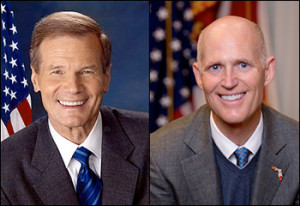By Jim Ellis
Oct. 23, 2018 — Four statewide Florida polls were just released, and we continue to see conflicting results across the board two weeks prior to Election Day. As usual, the Sunshine State political situation appears too close to call from a place that seems to specialize in razor-thin elections.
During the period of Oct. 17-21, St. Pete Polls, Survey USA, Quinnipiac University, and the Democratic polling firm of Schroth, Eldon & Associates all conducted Florida surveys.In the Senate race, two of the surveys find incumbent Bill Nelson (D) putting some distance between he and his opponent, Gov. Rick Scott (R), while the other two project to give Scott a slight edge. In the governor’s race, three of these firms released numbers (Quinnipiac did not, but will likely do so today), and Democratic nominee Andrew Gillum, the Tallahassee mayor, holds a varying lead over former US Rep. Ron DeSantis (R).
There is quite a difference in the Senate margins, and this is largely due to how the female vote is being recorded. Both Survey USA (Oct. 18-21; 1,050 Florida adults, 859 registered Florida voters, 665 likely Florida voters) and Quinnipiac (Oct. 17-21; 1,161 registered Florida voters) find Sen. Nelson holding full-sample leads beyond the polling margin of error, 49-41 percent (S-USA) and 52-46 percent (Quinnipiac). They see females breaking for Nelson, 49-37 percent (S-USA) and 59-39 percent (Quinnipiac). Men are going the opposite way, favoring Scott, 49-46 percent (S-USA) and 54-44 percent (Quinnipiac).
But St. Pete Polls (Oct. 20-21; 1,575 Florida voters, automated) and Schroth, Eldon & Associates (Oct. 17-20; 600 likely Florida voters) see things differently. St. Pete finds Gov. Scott leading the Senate race by a bare 49-48 percent cut. Schroth Eldon forecasts a similarly slim 47-45 percent Scott margin.
These latter polls paint a much different picture of the female vote. According to St. Pete, which reported a female-based gender sample of 54-46 percent, the vote is breaking in much closer proportion for each candidate. For Sen. Nelson, the female vote trended just 49-47 percent in his favor. Among men, Gov. Scott held a 51-47 percent advantage.
Schroth Eldon did not release its crosstabs, so we don’t have access into just how the genders separated. We do know, however, that 54 percent of this sample was comprised of females, and since the overall respondent universe produced a Scott statewide lead, the female vote must be more in line with what St. Pete found rather than Survey USA or Quinnipiac.
The governor’s race breaks more definitively for Democratic nominee Gillum – he leads in all three polls – and we see the same demographic patterns. St. Pete projects the closest race, with Gillum, who is up just 47-46 percent. Survey USA provides Gillum his best margin, 49-42 percent, while Schroth Eldon comes in close to that split at 48-42 percent.
Without Quinnipiac releasing gubernatorial numbers and no gender split for Shroth Eldon, we are left with looking to compare St. Pete Polls with Survey USA.
In this race, the gender splits are even more dramatic than for the Senate race. From Survey USA’s crosstabs, Gillum carries the female vote by a whopping 53-36 percent, but trails DeSantis among men, 48-46 percent. St. Pete finds the gender split to be much closer, however.
Instead of a 17-point difference between women and men as S-USA reports, St. Pete sees only a five-point variance, 49-44 percent, with men preferring DeSantis, 50-45 percent. But it does appear clear, whatever the margin may be, that the Democratic candidates are doing better with women, while men are more closely aligning with the Republican contenders.
With a large swing among these late-breaking polls, it again tells us that these races are quite close and likely not yet decided. With early voting already underway, both sides will pull out all of the stops to maximize their own coalition turnout.

